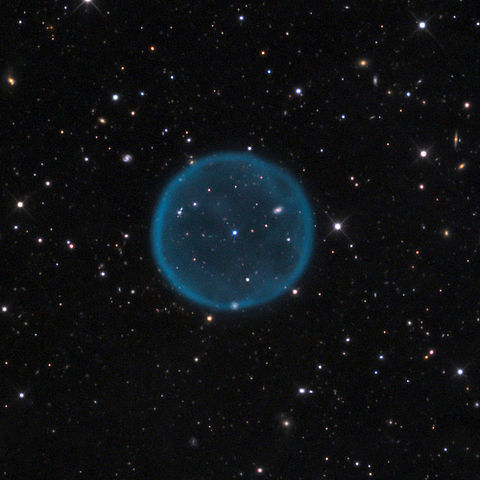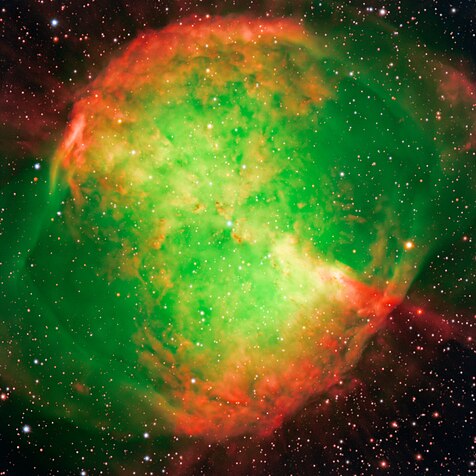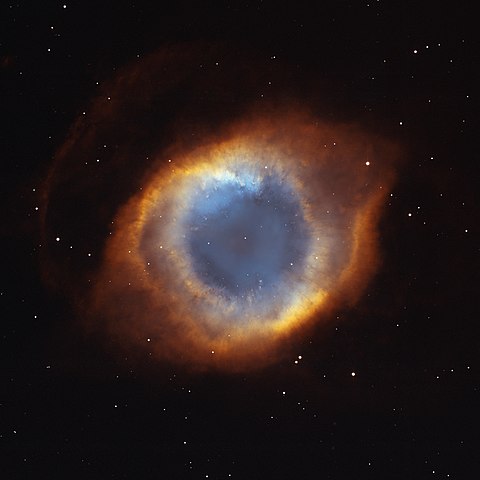
The Owl Nebula doesn't look so dramatic in my telescope as in this image, but it's still one of my favorite objects in the sky.
Nebulas
Nebulas, or, more properly, nebulae, are cloudy-looking objects in the sky. The word nebula is Latin for 'mist', 'cloud', or 'fog'. There are a lot of different types of things that look like a patch of cloud or fog in the sky. To give a brief list, there are reflection nebulas, emission nebulas, supernova remnants, and planetary nebulas. Each is different, and looks like a bit of cloud in a modest sized telescope. Even galaxies were once considered nebulas, before it was discovered how far away they are, and that they're made of stars like the Milky Way.
Planetary nebulas were given their name by William Herschel. He was trying to build a fairly comprehensive catalog of things in the night sky that aren't stars. He included a description of them in the Philosphical Transactions of the Royal Society, Volume 75 starting on page 263. You can read it, without pestering your local reference librarian, thanks to Google Books.
He chose the name because, though he knew they were nebulas, he also noticed that they tended to be somewhat round and that when magnified their brightness across their visible surface they tended to act like the illuminated disk of a planet, rather than like the other nebulas he had been observing. Sometimes it's implied that the name was given out of a mistaken sense that the objects have something to do with planets, but that's clearly not the case.
Stellar Remnants
Today, we know that planetary nebulas are made up of material that's been cast off a star when it goes from being a giant star (like a red giant) to being a white dwarf star. When this happens, the outer parts of the star that aren't involved in the nuclear reaction of the star (which happens at the core of a normal star) are blown off into space by bursts of energy from the core. The core collapses to form the white dwarf, the outer areas of the star, usually called the "atmosphere", though it's nothing like our atmosphere except that it happens to be the outer part of the star just as the atmosphere is outside the solid and liquid part of the Earth.
There are two basic types of planetary nebula, spherical and bipolar. The spherical ones appear to be stars that have blown off their atmosphere in a fairly uniform fashion.

Abell 39 is a perfect example of a spherical planetary nebula.
Bipolar planetary nebulas are ones where the material appears to be spread into two halves on opposite sides of the original star. Usually, each side looks like a mirror of the other half. One of the mysteries of planetary nebulas is why this happens, and how some of these beautiful forms come into being.

One of the brightest bipolar nebulas in the sky, the Dumbbell Nebula.
The bipolar nebulas appear to take on a wide range of shapes. In some cases, probably in many of these cases, the nebulas themselves are the same shape as each other, but look very different when seen from different angles. Dr. Bruce Balick has a great web page on this that includes lots of other information about planetary nebulas.
Seeing Planetary Nebulas for Yourself
Many planetary nebulas are bright enough to be seen easily. A few can be seen by eye, but they don't look as spectacular that way. The Helix Nebula is the closest known planetary nebula, and it can be seen by eye about 1/3 of the size of the Moon (when I look at it, it actually looks closer to half the size of the Moon, but that's probably just an optical illusion.) But it's very dim, because its light is spread out over such a large area. It looks more like a slightly light patch of sky than like a nebula.

The Helix Nebula is visible by eye but it's not this dramatic and colorful.
Binoculars do a great job of bringing it out and making it look brighter. You still won't see what the Hubble Telescope sees, but it will be worth your while.
A modest sized telescope will bring out detail in about another one or two dozen planetary nebulas in the sky. The Dumbbell, above, shows its "apple core" shape to even a small telescope at low magnifications.
The Future of Our Sun
Present thought is that our own sun will create a planetary nebula of its own in the far future, several billion years from now. First it will become a red giant by puffing up its outer parts, then the core will collapse and the outer gases will be blown off into the space around it.
I've heard mixed predictions of whether the resulting planetary nebula would be visible from within the solar system. Since the Earth will be destroyed during the red giant phase of the Sun, unless a future project relocates it somewhere to move it outside the space that the Sun will swell up into as a red giant, it'll be pretty much an academic question, anyway.
I recently gave a talk on Planetary Nebulas to the Nevada County Astronomers. You can see the slides from my talk on my website.



No comments:
Post a Comment